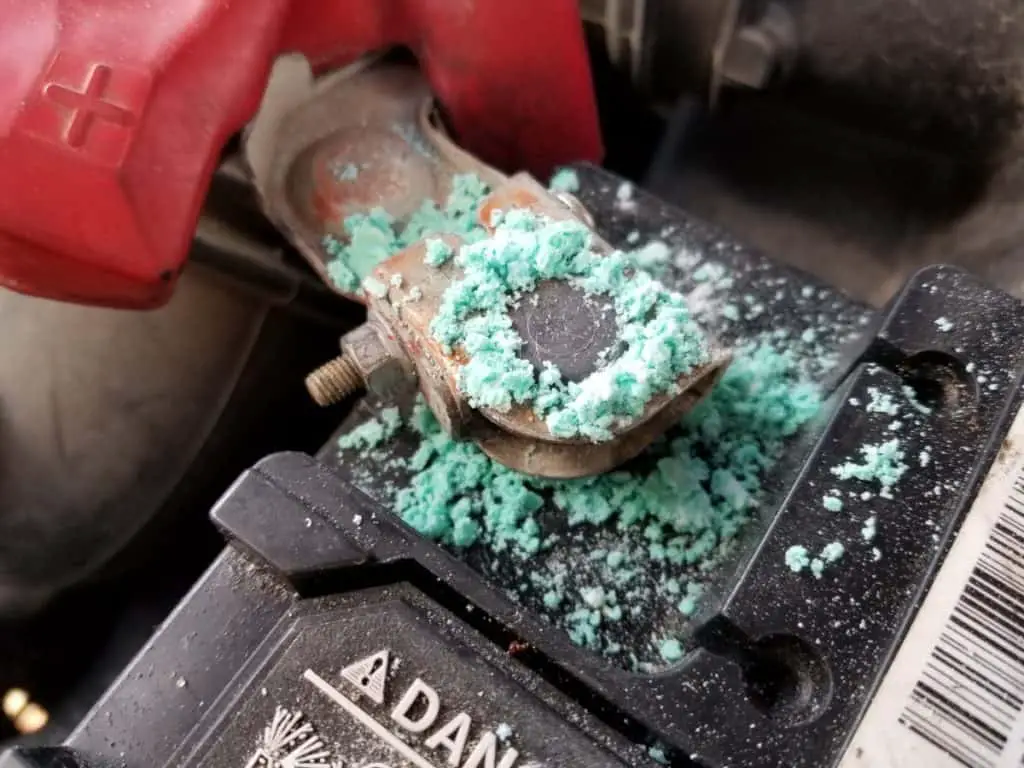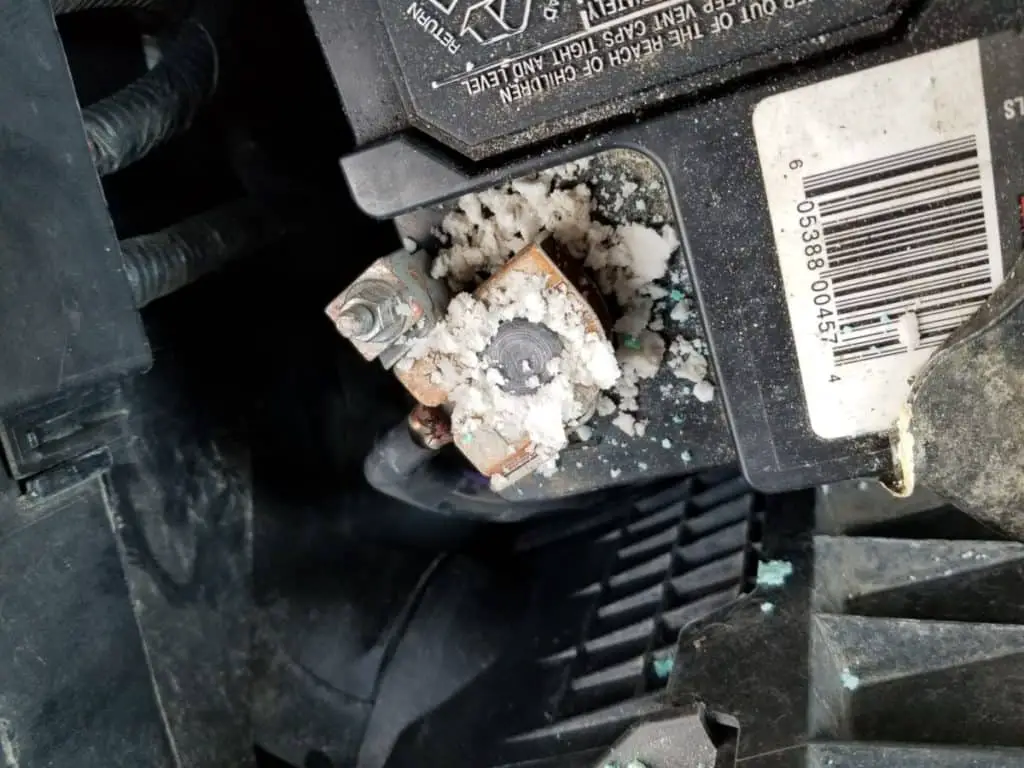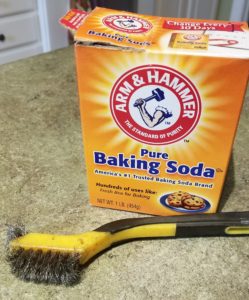At some point in your life, you’ve likely seen that white or blue-green corrosion that seems to sprout out of a car battery’s terminals.
Hopefully, that problem has never plagued you and you’re just asking for a friend. Regardless, we’re going to cover why it happens and what you can do about it.
A battery’s positive terminal will corrode to copper sulfate which is blue in color and is the result of the battery overcharging. The negative terminal will have white corrosion which is lead sulfate and is the result of the battery being undercharged.
Corrosion Reasons on Car Battery Terminals
| Battery Terminal | Corrosion and Color | Likely Reason |
|---|---|---|
| Positive (Red Cable) | Copper Sulfate (Blueish Green) | Overcharging (Faulty Voltage Regulator) |
| Negative (Black Cable) | Lead Sulfate (White) | Undercharging (Frequent, short drives) |
I’m going to cover in more detail why each particular terminal corrodes, if it’s normal, if it can really affect your car from starting, if it’s dangerous, how to clean it, and how to prevent it from the start or in the future.
Let’s get started!
Why is the Positive (Red) Terminal of my Car Battery Corroded?

If you see corrosion or build-up on the positive terminal of your car battery it will generally have a bluish or greenish color to it. This is due to copper sulfate as the product of a chemical reaction between the copper in the terminal clamp, moisture in the air, lead in the battery post, sulfuric acid in the battery, and excess electricity.
The primary reason corrosion will occur on the positive terminal is due to your battery overcharging.
The main culprit for this would be a faulty voltage regulator or some other aspect of your alternator, which is designed to keep your battery properly charged as you drive. If it is perpetually overcharging, your battery is also outgassing and losing water out of the electrolyte solution due to heat and evaporation.
Why is the Negative (Black) Terminal of my Car Battery Corroded?
On the negative terminal of the battery, you’ll generally see a white and crusty build-up. This is lead and sulfuric acid that is caused by the battery remaining perpetually in a state of being undercharged.
Again, a faulty voltage regulator in the alternator could be the issue, but often it is caused by our driving habits.

Only using your vehicle for very short trips doesn’t allow the alternator to fully charge it after the initial start-up process. Draining your car’s battery with lights and the radio while not running can all add to the problem.
Every time you start your car, the battery gives up about 1-2% of its energy in a couple of seconds. If you live in a town or city and make a multitude of 5-minute trips every day, your alternator simply does not have the time to properly bring your battery up to a full charge.
Combine that with sitting in your car in your driveway or a parking lot while you’re playing on your phone while it’s charging off of your car battery, the headlights and radio are on (powered by that same car battery), but the engine is off (not being recharged by the alternator) and you’ll be headed for battery corrosion fast.
You can even make things worse by only driving your car in this manner on weekends. As it sits unused throughout the week, the battery is subject to a parasitic draw from your car’s internal computer systems. It’s not a lot, but it adds up after days of non-use — especially if you left it in an undercharged state to begin with.
Is it Normal for my Car Battery to Corrode?
It is not normal for your car battery to corrode if the alternator is given ample time to fully recharge your battery when driving, the voltage regulator isn’t faulty, and you don’t let your car sit idle for months without use. Checking your car battery’s electrolyte level and specific gravity monthly is recommended.
Avoiding excessive 5 to 10-minute trips without any longer ones to recharge your battery is the easiest way to make sure your battery won’t be undercharged (assuming your voltage regulator on your alternator is functioning as it should).
Checking your battery’s electrolyte level at least monthly is an easy way to see if your levels are low and if overcharging might be occurring. If they are low (especially frequently), it’s a good indication that your battery is overcharging since doing so will cause excess heat and cause the water to evaporate and vent out of your battery.
If your levels are low, but still above the lead plates (just cover with distilled water only if they are below the plates), it is recommended to first charge your battery with a 3-stage smart charger. When it is fully charged, add only distilled water (I use a syringe to avoid spilling) into each cell that is low until the water level is just below the fill tube that extends down into the cell.
Then, reconnect it to the charger and bring to a full charge once again.
If your battery is frequently low each time you check it, it is recommended to get your alternator looked at by a trusted mechanic.
Can Corroded Battery Terminals Cause a Car not to Start?
Corroded battery terminals can certainly cause your car not to start. Copper sulfate (positive terminal) and lead sulfate (negative terminal) both reduce the conductivity between the battery terminal posts and the wires attaching to them, as well as reduce the conductivity between the plates within the battery itself.
Remember, especially with corrosion on the negative terminal, that lead sulfate is a problem which starts first within the battery itself. Being undercharged, even for a short time, will cause sulfation within the battery itself as the electrolyte solution (sulfuric acid and water) is not at a proper balance amongst the lead plates.
At first, when the sulfate deposits appear, they can be reversed with a controlled overcharge to break them up (desulfation). Many newer smart chargers have such a feature and they will take the battery’s voltage up to 15-16 volts to agitate the electrolyte solution and dislodge the sulfate deposits from in between the plates.
If the deposits are allowed to sit, they will harden and as the chemistry gets worse in the battery, the deposits will creep up the battery terminal.
So, if you see deposits on the negative terminal post of your battery, you can be certain that you also have internal damage to your battery as well and much of it may not be irreversible.
Is Corrosion on my Car Battery Dangerous?
Corrosion on a car battery is dangerous to the lifespan and efficacy of your battery, to your clothes if you try to clean it, and can cause skin irritation if proper protective equipment is not used. Obviously, contact with eyes or internally consuming lead sulfate or copper sulfate would be extremely harmful.
Beyond that, the lead sulfate is dangerous to waterways and anything you might touch afterward since it has lead in it. Place cardboard underneath your car’s engine when attempting to clean your terminals in case any of the powder falls down.
Lead sulfate could be on your driveway and then in a puddle that your pet drinks out of or your kids play in.
How to Clean Corrosion off Your Car Battery
First and foremost, always wear proper protective equipment when handling batteries. This means always having proper gloves and eye protection. A close second is having clothing that you don’t mind getting ruined. No matter how careful you think you’re going to be, you will end up with a small hole somewhere in your favorite jeans!

When checking my batteries, I always keep at least a gallon of water in a bucket right next to me in case a little acid splashes on me or corrosion gets on my skin. Immediately submerge the affected area in the water for a minute to dilute the effects. As long as it didn’t go in your eyes, you should be fine after doing this.
If you fail to do it, you’ll notice your skin start to feel irritated and burn within a minute’s time. Trust me, I know.
To remove the copper sulfate or lead sulfate, I think it’s best to use a paste of baking soda and water in order to neutralize the pH of the sulfates. Scrub with wire-brush and finish up with a damp rag after it sits for a while.

Disconnect the battery from the vehicle before working on it. You might need to use pliers to free the cables if the corrosion is too thick. Make sure not to ever touch something metal so that it stretches from one terminal to the other on the battery!
Make sure that this baking soda solution does not enter into the cells of the batteries! Bad things will happen to good people if you do this!
Ensure that the cover for the cells is properly in place and not compromised, and always clean away from the terminals to the edge of the battery away from the cells to avoid any problems.
You will likely have just as much success removing the corrosion with WD-40 like many online forums claim to use, but you won’t be neutralizing the corrosion that way. You’ll just be moving it from the battery terminal into the rag that you use to wipe it off.
How do you Stop Corrosion on Car Battery Terminals?
- Make sure your connections to the battery are cleaned and tight from the beginning.
- Having lead connectors to the lead terminals will help solve the problem as well. Often the corrosion is a reaction between the two different types of metal at the battery terminal. Keeping them the same will reduce the problem.
- Have your voltage regulator checked out (alternator) if you’re noticing corrosion — especially if it originates from the positive battery terminal.
- Make sure you don’t only take very short trips.
- If only taking short trips is your normal routine, invest in a battery charger. My favorite for a situation like this to just bring a battery up to full health would be this charger from Amazon. I’ve used it for years and it’s never failed me. You can just pop the hood, connect the clamps to the proper terminals, then plug the charger in and shut the hood and leave it overnight. Leave a note on your steering wheel as a reminder that it’s under the hood so you don’t start driving away in the morning!
- Do a controlled overcharge (desulfation) every few months especially if you notice corrosion starting on the negative terminal. Remember that the corrosion on the negative terminal started from the inside out. The sooner you can break up the sulfation within the battery with a controlled overcharge, the better off you’ll be with the lifespan of your battery!
- Many 3-stage smart chargers have a “desulfation” or “recovery” mode. If you run this process, it will send your battery into the 16-volt range. This will cause your battery to sound like it’s rigorously bubbling and it will be off-gassing, so make sure to do this outdoors if possible. I have an article on bubbling batteries here if you’d like to learn more.
- Vaseline (petroleum jelly) can be added to the terminals upon installation or after you clean them of corrosion. This will keep them looking clean. However, it will only mask the symptoms so that you don’t notice the underlying problem. If you notice corrosion starting on either terminal, you can start to address the issue based on the particular terminal. If you never see the corrosion, it doesn’t mean that you still don’t have an undercharging or overcharging battery, you’re just not seeing it. The damage is still occurring on the inside.
